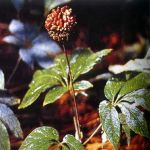| Common Name: |
San Qi Ginseng |
| Other Names: |
Sanchi ginseng, tienchi ginseng |
| Botanical Name: |
Panax pseudoginseng var. notoginseng |
| Genus: |
Panax |
| Family: |
Araliaceae |
| Cultivation: |
Moist, well-drained, rich soil in shade, with ample warmth and humidity during the growing season. |
| Propagation: |
By seed sown 2.5cm (1in) deep when ripe. Keep seed in damp moss before sowing; do not allow to dry out. Germination is slow and erratic. |
| Harvest: |
Roots are lifted from 6-7-year-old plants in autumn and used fresh or dried in decoctions, liquid extracts, pills and powders. Processing of P. ginseng varies according to product and quality. Red ginseng is steamed, heat-dried, then sun-dried; white ginseng is peeled and dried for chewing. Flowers are picked in spring and summer for decoctions. |
| Native Location: |
Mountain and woodlands in S China (Yunnan) |
| Height: |
90cm (3ft) |
| Width: |
75cm (30in) |
| Hardiness: |
Z6 |
| Parts Used: |
Roots (occasionally flowers) |
| Properties: |
A bittersweet, warming herb that controls bleeding, reduces inflammation, relieves pain, improves circulation and function of adrenal glands, and has anti-bacterial effects. |
| Medicinal Uses: |
Internally for coronary heart disease and angina (roots), dizziness, and vertigo (flowers). Internally and externally for nosebleed, and hemorrhage from lungs, digestive tract, uterus, or injuries (roots). |
| Precaution: |
Contraindicated during pregnancy. |
| Culinary Uses: |
Roots are added to tonic soup. |
| Bibliography: |
The Encyclopedia of Herbs by Deni Bown Copyright © 1995, 2001 Dorling Kindersley Ltd. pp 299-300. |

